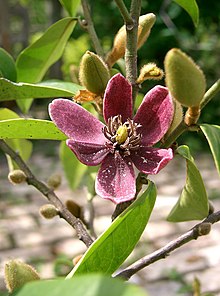
Back ماجنوليا فيجو ARZ Magnolia figo CEB Magnolia figo German Magnolia figo French Cempaka mulia ID Magnolia figo Italian カラタネオガタマ Japanese ចម្ប៉ាខែក Cambodian Cempaka keling Malay Magnolia figo Romanian
| Magnolia figo | |
|---|---|

| |
| Cultivar 'Purple Queen' | |
| Scientific classification | |
| Kingdom: | Plantae |
| Clade: | Tracheophytes |
| Clade: | Angiosperms |
| Clade: | Magnoliids |
| Order: | Magnoliales |
| Family: | Magnoliaceae |
| Genus: | Magnolia |
| Subgenus: | Magnolia subg. Yulania |
| Section: | Magnolia sect. Michelia |
| Subsection: | Magnolia subsect. Michelia |
| Species: | M. figo
|
| Binomial name | |
| Magnolia figo (Lour.) DC.
| |
| Synonyms | |
|
Liriodendron figo | |
Magnolia figo (also called banana shrub, port wine magnolia, Michelia figo) is an evergreen tree in the magnolia genus. It grows to 3–4 metres (10–13 feet) tall. It is native to China.
Initially described by Portuguese missionary and naturalist João de Loureiro as Liriodendron figo, it was reclassified as Michelia figo by German botanist Curt Polycarp Joachim Sprengel. In 2006, a cladistic analysis of the genus Michelia found them to lie within the genus Magnolia, with the name now being Magnolia figo.
It is cultivated as an ornamental plant in gardens for its fragrant flowers, which are cream-white and sometimes yellow, purple rounded, or light-purple, and strongly scented with isoamyl alcohol.[2] It is also popular to keep M. figo as a houseplant. Flower buds, as well as new leaves, are covered with hairs, giving it a texture similar to that of velvet. The leaves are leathery, dark glossy-green, up to 10 cm long. This plant is used in Shanghai, China, as a tall evergreen hedge. It grows very slowly and matures into a large evergreen compact tree. It grows in acid and alkaline soil very well, but is susceptible to black soot.
- ^ "IUCN Red List of Threatened Species: Magnolia figo". 26 September 2012.
- ^ Knudsen, Jeite T.; Tollsten, Lars; Bergstrom, L. Gunnar (1993). "Floral Scents - A Checklist of Volatile Compounds Isolated by Head-Space Techniques". Phytochemistry. 33 (2): 253–280. doi:10.1016/0031-9422(93)85502-i.
